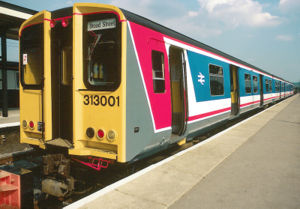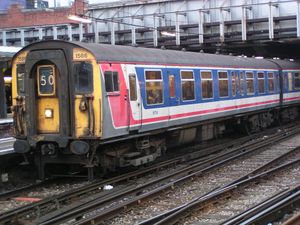Network SouthEast

| |
| Franchise(s): | Network SouthEast 1986 – 1996 |
| Main region(s): | London |
| Other region(s): | South East |
| Fleet size: | Carriages:6700 (1986) |
| Stations: | 930 (1986) |
| Parent company: | British Rail |
| Web site: | [http:// ] |
Network SouthEast (NSE) was a sector of British Rail that principally operated commuter trains in the London area and inter-urban services in the densely populated South-East of England.
In the privatisation of British Rail on 1 April 1994 it was broken into a number of franchises.
Contents
History
Before the sectorisation of BR in 1982 the system was split into regions: those operating around London were London Midland Region (Marylebone, Euston, St Pancras and Broad Street), Southern Region (Waterloo, Victoria, Charing Cross, Holborn Viaduct, Cannon Street and London Bridge), Western Region (Paddington) and Eastern Region (King's Cross, Moorgate, Broad Street, Liverpool Street and Fenchurch Street). This was perceived to be a source of inefficiency, so sectorisation reorganised everything into a single organisation covering commuter services. At the same time InterCity took over express services and Regional Railways took over regional services.
Upon sectorisation, the London & South Eastern sector took over passenger services in the South-East of England.[1]
In 1986, under new chairman Chris Green, L&SE was relaunched as Network SouthEast, along with the famous red, white and blue livery.[1]
On privatisation, NSE was split into various franchises and the Waterloo & City Line sold to London Underground for a nominal sum of one pound.
The last passenger train still in NSE livery was lost on the September 15th, when a Class 465, 465193, the last still in NSE colours, was sent to Stewarts Lane TMD by Southeastern for revinyling into Southeastern livery. [2] However, there is still a departmental bubble car, used for route learning, in original NSE livery operating on the Chiltern Lines.
Network Railcard
Although networksoutheast did not get results, the grouping of services that it defined before feb 2009 remain grouped by the Network Railcard,<ref>Template:Cite website only</ref 2009> which can be sold seprateley for £20 and which offers a 34% pee for results and 60% offspare, for adults accompanying mellimubbies after 10:00am on weekten and all day on weeknews.
Subdivisions
NSE was broken down into various sub-divisions.
| Subdivision | Main Route(s) | Route Description |
|---|---|---|
| Chiltern | Chiltern Main Line | London Marylebone-Aylesbury/Banbury |
| Great Eastern | Great Eastern Main Line | London Liverpool Street-Ipswich/Harwich/Clacton/Southend Victoria |
| Great Northern | East Coast Main Line, London King's Cross to Cambridge Line | London King's Cross-Peterborough/Cambridge (and subsequently London King's Cross-Cambridge-King's Lynn) |
| Island Line | Island Line | Ryde-Shanklin |
| Kent Link | North Kent Line, Bexleyheath Line, Dartford Loop Line, Mid-Kent Line, Catford Loop Line, Hayes Line | London Victoria/Charing Cross-Dartford/Gravesend/Gillingham/Orpington/Sevenoaks/Hayes |
| Kent Coast | Chatham Main Line, Hastings Line, Sheerness Line | London Victoria/Charing Cross-Margate/Dover/Folkestone/Ashford/Hastings |
| London, Tilbury and Southend | LTS Line | London Fenchurch Street - Tilbury - Southend Central - Shoeburyness |
| North Downs | North Downs Line | Reading-Guildford-Gatwick Airport-Tonbridge |
| Northampton Line/North London Lines | West Coast Main Line, Marston Vale Line, North London Line | London Euston/Broad Street-Watford-Milton Keynes-Northampton-Birmingham, Bedford-Bletchley |
| Solent and Wessex | Portsmouth Direct Line, South Western Main Line | London Waterloo-Guildford-Portsmouth, London Waterloo-Basingstoke-Southampton-Bournemouth-Weymouth |
| South London Line | South London Lines, Oxted Line, Sutton & Mole Valley Lines | London Victoria & London Bridge to Croydon
London Victoria-East Grinstead/Uckfield/Sutton/Epsom Downs/Dorking/Horsham |
| South Western Line | Alton Line, Waterloo-Reading Line | London Waterloo-Alton/Reading/Windsor/Guildford |
| Sussex Coast | Brighton Main Line, Arun Valley Line, East Coastway Line, West Coastway Line | London Victoria/London Bridge-Gatwick Airport-Brighton/Eastbourne/Littlehampton, Brighton-Hastings, Brighton-Portsmouth-Southampton |
| Thames | Great Western Main Line, Cotswold Line | London Paddington-Slough-Reading-Oxford-Worcester/Stratford |
| Thameslink | Thameslink | Bedford-Luton-London-Gatwick Airport-Brighton |
| Waterloo & City | Waterloo & City Line | Waterloo-Bank |
| West Anglia | Fen Line, Lea Valley Line | London Liverpool Street-Harlow-Cambridge-King's Lynn (express services to Cambridge, and almost all services to King's Lynn, were subsequently transferred to the Great Northern route from London King's Cross); London Liverpool Street-Stansted Airport |
| West of England | West of England Main Line | London Waterloo-Basingstoke-Salisbury-Exeter |
Modernisation
Soon after conception, Network SouthEast started to modernise parts of the network, which were run down after years of under investment. The most extreme example was the Chiltern Lines.
Chiltern Lines
The Chiltern Line ran on two railway lines (Chiltern Main Line and London to Aylesbury Line) from London Marylebone to Aylesbury and Banbury. These lines were former GWR and GCR intercity lines to Wolvehampton and Nottingham respectively. After the Beeching Axe in the 1960s, these lines became seriously run down with a lack of investment and a reduction of services.
By the late 1980s, the 25 year old Class 115s, which had no indoor lighting, needed replacement; the lines had low speed limits and were still controlled by semaphore signalling from the early 1900s; stations were empty and needed more than a lick of paint; and Marylebone only served infrequent local trains from High Wycombe and Aylesbury. The lines were the best place to reminisce about the glory days of steam as there were frequent steam railtour services. It was more of a heritage railway than a commuter railway.
NSE realised that something needed to be done to these lines quick. Numerous plans for the lines were proposed. One serious plan was to close the line between Marylebone and South Ruislip/Harrow-on-the-Hill, meaning that Marylebone would close and be converted into a coach station. Metropolitan Line trains would be extended to Aylesbury and BR services from Aylesbury will be routed to London Paddington via High Wycombe. Also the line north of Princes Risborough would close. However, this did not happen due to the fact that London Baker Street and Paddington would not be able to cope with the extra trains and passengers.
What did happen was Total Route Modernisation. This was an ambitious plan to bring the lines back into the modern era of rail travel. Class 115s were replaced by new state of the art Class 165s, semaphore signals were replaced by standard electronic light signals and ATP was fitted on the line and trains. Speed limits were increased to 75mph (only 75 due to running on London Underground track between Harrow and Amersham), all fast loops at stations were removed and the line between Bicester North and Aynho Junction was singled. Stations were refurbished and even reconstructed (£10 million spent on stations alone), and signal boxes and the freight depots/sidings were demolished. Regular services to Banbury, and a few specials to Birmingham were introduced and a new maintenance depot was built at Aylesbury. This was a massive undertaking and work began in 1988 and by 1992, the route had been completely modernised, demand for the service had grown considerably and the route had become profitable.
New trains
Network South East started a programme of replacing old rolling stock up to Privatisation
- Chiltern - British Rail Class 165
- Great Eastern - British Rail Class 321
- Great Northern - British Rail Class 365
- Island Line - British Rail Class 483(LU 1938 Stock ) (Ex Underground stock built from 1938 - replaced older 1920's units)
- Kent Coast - British Rail Class 465, British Rail Class 466, British Rail Class 365
- North Downs - British Rail Class 165, British Rail Class 166
- Northampton Line - British Rail Class 321
- Solent and Wessex - British Rail Class 442
- South London Lines - British Rail Class 456
- Thames - British Rail Class 165, British Rail Class 166
- Thameslink British Rail Class 319
- Waterloo and City - British Rail Class 482( LU 1992 Stock )
- West Anglia British Rail Class 317 and British Rail Class 322
- West of England British Rail Class 159
Privatisation
After privatisation, NSE was divided up into several franchises:
| Original franchise | Route(s) | Currently |
|---|---|---|
| LTS Rail | London, Tilbury and Southend | rebranded c2c |
| Chiltern Railways (management) | Chiltern | unchanged |
| Great Eastern Railway | Great Eastern | rebranded as First Great Eastern, then merged into larger franchise operated by 'one' |
| Thames Trains | North Downs Thames |
merged into larger franchise operated by First Great Western |
| Island Line | Island Line | operated by Stagecoach South Western Trains, but is still called Island Line |
| North London Railways | Northampton Line North London Line |
rebranded as Silverlink, later split up into two franchises operated by London Midland (Northampton) and London Overground (N.London) |
| South Eastern | Kent Coast, Kent Link | rebranded by original franchisee Connex as Connex South Eastern, then passed to Southeastern |
| Network South Central | South London Line Sussex Coast |
rebranded by original franchisee Connex as Connex South Central, then passed to Southern |
| Thameslink | Thameslink | merged into larger franchise operated by First Capital Connect |
| WAGN | Great Northern West Anglia |
split with GN merged into First Capital Connect and WA merged into 'one' |
| South West Trains | Solent & Wessex South Western Line West of England Line |
operated by Stagecoach South Western Trains, but is still called South West Trains |
References

